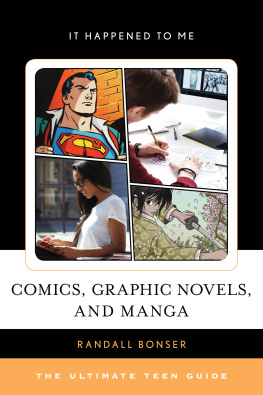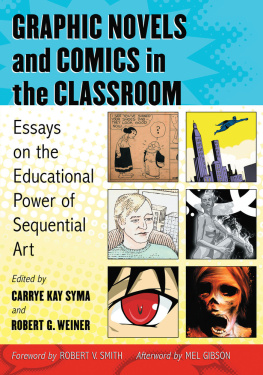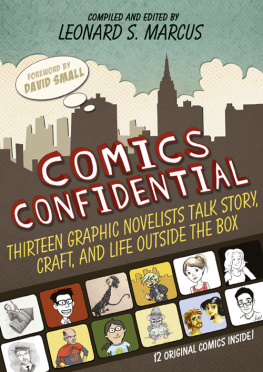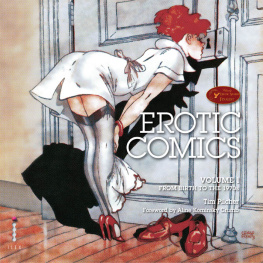
COMICS
AND
Sacred Texts

UNIVERSITY PRESS OF MISSISSIPPI / JACKSON
The University Press of Mississippi is the scholarly publishing agency of the Mississippi Institutions of Higher Learning: Alcorn State University, Delta State University, Jackson State University, Mississippi State University, Mississippi University for Women, Mississippi Valley State University, University of Mississippi, and University of Southern Mississippi.
www.upress.state.ms.us
The University Press of Mississippi is a member of the Association of University Presses.
Copyright 2018 by University Press of Mississippi
All rights reserved
Manufactured in the United States of America
First printing 2018
Library of Congress Cataloging-in-Publication Data
Names: Gamzou, Assaf, 1984 editor. | Koltun-Fromm, Ken, editor.
Title: Comics and sacred texts : reimagining religion and graphic narratives / edited by Assaf Gamzou and Ken Koltun-Fromm.
Description: Jackson : University Press of Mississippi, [2018] | Includes bibliographical references and index. |
Identifiers: LCCN 2018017931 (print) | LCCN 2018020181 (ebook) | ISBN 9781496819222 (epub single) | ISBN 9781496819239 (epub institutional) | ISBN 9781496819246 (pdf single) | ISBN 9781496819253 (pdf institutional) | ISBN 9781496819215 (hardcover : alk. paper) | ISBN 9781496819475 (pbk. : alk. paper)
Subjects: LCSH: Comic books, strips, etc.Religious aspects. | Comic books, strips, etc.Criticism and interpretation. | SuperheroesReligious aspects. | Popular cultureReligious aspects.
Classification: LCC PN6712 (ebook) | LCC PN6712 .C53 2018 (print) | DDC 741.5/382dc23
LC record available at https://lccn.loc.gov/2018017931
British Library Cataloging-in-Publication Data available
CONTENTS
ASSAF GAMZOU AND KEN KOLTUN-FROMM
MADELINE BACKUS AND KEN KOLTUN-FROMM
SUSAN HANDELMAN
LEAH HOCHMAN
A. DAVID LEWIS
KARLINE MCLAIN
ELIZABETH RAE COODY
RANEN OMER-SHERMAN
SCOTT S. ELLIOTT
SAMANTHA LANGSDALE
JEFFREY L. RICHEY
SAMANTHA BASKIND
OFRA AMIHAY
SHIAMIN KWA
JOSHUA PLENCNER
LEONARD V. KAPLAN

ACKNOWLEDGMENTS
ALL BOOKS HAVE ORIGIN STORIES, AND THIS ONE BEGAN WITH A SMALL but influential conference held at Princeton University in April 2015. Frames: Jewish Culture and the Comic Book was a two-day event orchestrated by Charlotte Werbe and Marie Sanquer. The conference was extraordinarily rich and diverse, with an accompanying exhibition and papers from prominent and emerging scholars (one of whom, A. David Lewis, is also a contributor to this book). It was there that we first met, and over coffee the next day we sketched out this project.
After receiving strong interest from a call for papers, we quickly moved to establish our own conference symposium on Sacred Texts and Comics at Haverford College in May 2016, hosted by Ken Koltun-Fromm and supported by the Hurford Center for the Arts and Humanities. With an exhibition curated by Assaf Gamzou, the conference offered panels, paper presentations, and workshops from contributors to this volume. We wish to thank the Hurford Center at Haverford College for its support and encouragement, together with the artists featured in the exhibition, Biblical Proportions: Stories from the Testaments in Comics: Shay Charka, Zev Engelmayer, Miriam Katin, Peter Kuper, Strakings and Henry Flint, Chris Ware, and works from Will Eisner, made available through the caretakers of his estate, Denis Kitchen and Carl and Nancy Groper. Ken is especially grateful to his students from Reading Comics and Religion and our visiting artist J. T. Waldman, who all helped to shape our understanding of comics and the sacred, and who actively constructed and participated in the symposium. Without the administrative support and contribution from students and artists alike, the symposium could not have been the success that it surely was, and a small but fervent community of scholars owes a debt of gratitude to all involved.
Thanks too are in order for the staff of the Israeli cartoon museum for their support: Galit Gaon, the founder and chief curator, for her vision and support for what sometimes seemed like very strange ideas, and Dikla, Hilla, Amnon, and Michal for their continued work and effort.
We wish to thank the University Press of Mississippi for its continued and valuable support for this project, especially our editor Vijay Shah and editorial assistant Lisa McMurtray. We also received kind help from Carla Speed McNeil, who illustrated the wormhole for , and Neta Manor, who helped with images throughout the book.
Assaf wishes to personally thank his family: My one and only partner in crime, Michal, and my children, Shelly and Dori: you give meaning to this and any other endeavor I undertake, and force me, every day, to try and be who I want to be for you. Without you this would not be possible, or worthwhile.
We dedicate this book to Kens colleague at Haverford College, Robert Germany, who taught us the joys of intellectual creativity, and who died much too young to see the fruits of his glorious labor.

COMICS AND SACRED TEXTS
ASSAF GAMZOU AND KEN KOLTUN-FROMM
ROBERT ORSI TELLS A WONDERFUL STORY ABOUT HIS STUDENTS IN HIS US urban religion class. As he recounts his visit to St. Lucy, a Catholic church in the North Bronx, his students become visibly uneasy, even horrified, as they learn how the congregants would use holy water for apparently mundane things. For the water streaming from the Bronx grotto was thought to be the same miraculous water flowing in Lourdes, France, where Mary had revealed herself to a young woman in 1858. Pilgrims traveled to Lourdes to bathe in its salvific springs; so too this Italian Catholic community would turn to the Bronx grotto, built in 1939, for similarly edifying results. Yet not only did these believers drink from the well and pour water over themselves as a kind of protective covering, but men in shorts and t-shirts filled their radiators with Bronx Lourdes water for protection on the road. When Orsi asked an older woman about the source of this sweet water, she answered in a rather irritable tone, Its city waterit comes from the reservoir, I guess. Yet it is Orsis punch-line that tends to rattle his students: Later I was told by one of the caretakers at the grotto that no one really believed the story about the underground spring; everyone knows exactly where the water comes from and everyone maintains the water is holy and powerful (35).
Orsi, along with colleagues whose scholarship engages the material and lived practices of religious actors, persistently undermines presumptions about religion and the sacred, and so do the comics discussed in this volume, Comics and Sacred Texts: Reimagining Religion and Graphic Narratives. Collectively, these essays argue that the sacred appears in unusual and often overlooked places to offer new visionary modes for recognizing the sacred. We claim that seeing the sacred is a learned practice, and these collected essays are pedagogical texts designed to frame that learning. We must learn where to look for and how to envision the sacred. In seeing the sacred anew, graphic narratives play a key role in exploring how the sacred appears in image and text. As a visual and textual medium, comics expose the graphic interplay of seeing the sacred and reading about it. In this imagined, visual/textual space, the graphic narratives discussed in
Next page









